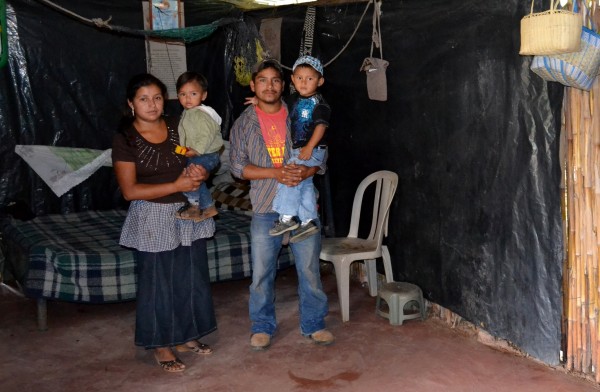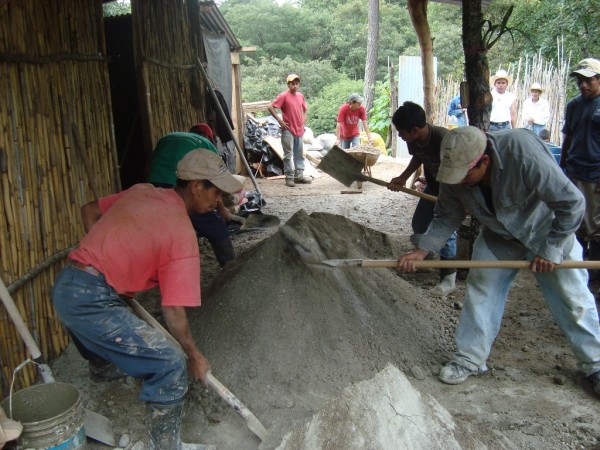- P.O. Box 110221 Naples, FL 34108
- 941-244-8692
- peopleforguatemala@gmail.com

Healthy Homes – One Floor at a Time

Stroll along the rolling hills outside of Antigua, Guatemala, and you see the tiny, thatched huts of local villagers and farmers amid the cornfields and steep slopes of the emerald countryside.
Huts are a single, square room. In one corner is an open fire stove still smoldering to keep the family warm during the night. In the rest, parents and perhaps half-a dozen young children spread out on the dirt floor to sleep.
Most are made of mud, cornstalks and gap-toothed boards. When it rains, June through October, the floors turn to a soupy sludge, 6 inches deep. The walls weep wetness into the dark interior.
But in those hills, one hut stands out. On a ledge overlooking lush farmlands, sits a house with a new concrete floor. That house and others like it in the hills in the highlands near San Martin, Jilotepeque, wouldn’t exist without the generous support of donors.
Covering dirt floors with concrete floors immediately improves the health of the entire family. “Back in 2010 we were building houses but realized the donations could help more families by improving their existing houses rather than building new ones. We changed our focus so donations go farther and more families are helped” said Ken.
According to a World Bank study covering dirt floors with concrete leads to a 78% reduction in parasitic infestations, 49% reduction in diarrhea, 81% reduction in anemia and a 36% to 96% improvement in cognitive development in children
Locals possess only hoes and machetes (the latter of which is used on everything from fingernails to fruit). The trek up the mountain is not easy to improve houses for local families living below the poverty line. There are no cement trucks to deliver ready mixed concrete. Instead, the 90 pound bags of cement, sand and gravel are carried on their backs across slippery paths to the house receiving the new floor. Roads are sparse and unpaved, and electricity is an anachronism, and every project comes with its share of technical challenges.
 Workers mix cement on site by corralling the gritty goo in a man-made pit (no plastic tubs, etc.) and churning it about with hoes and buckets of water (no faucets or hoses). Each floor takes one week to finish, depending on glitches and weather.
Workers mix cement on site by corralling the gritty goo in a man-made pit (no plastic tubs, etc.) and churning it about with hoes and buckets of water (no faucets or hoses). Each floor takes one week to finish, depending on glitches and weather.
The Healthy Homes project requires each family to make a small financial commitment and provide all of the labor. Five families must work together so everyone helps each other. Men level the dirt floor or mix concrete, women cook lunch for the crew of neighbors on work days. Many times there are 20 men and women at the house. After the floor project is finished most families work to receive a composting latrine. Better living conditions improves the family’s health thus improving each community as a whole.
“What we realized after the first 16 floors was each family made additional improvements on their own”, said Ken, co-founder of People for Guatemala, Inc. Each family upgrades their lamina roof, replaces the cornstalk walls with wood, or expands their porch. On one visit to a family with a new concrete floor a father explained, “This is the first time our 5-year-old son has had a place to play”. Another mother proclaimed, “This new floor has changed my life. I can let my 3-year-old daughter play on the floor. Until now I had to carry her all day because our floor was made of mud.”
The ultimate goal in every project is to teach the local people new skills and give them a hand up, not a hand out. A family can’t possibly save enough money to buy the materials when most families survive on less than $3 a day. For every family receiving a cement floor dozens more families make requests.
For more information and to make a donation please visit our website at www.peopleforguatemala.org. Ken & Lois Werner, Naples residents for 22 years, founded People for Guatemala in 2010 and have called Guatemala home for the past 6 years. Their humanitarian work focuses on health and education in rural Mayan villages. Projects include building schools, conducting medical clinics, classroom support, installing computers in elementary schools, scholarships for junior high and high school students, installing efficient low smoke stoves, and water projects.
